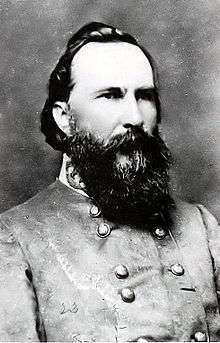Battle of Rice's Station
| Battle of Rice's Station | |||||||
|---|---|---|---|---|---|---|---|
| Part of the American Civil War | |||||||
| |||||||
| Belligerents | |||||||
|
|
| ||||||
| Commanders and leaders | |||||||
| John Gibbon | James Longstreet | ||||||
| Strength | |||||||
| 7,500 [1] | 6,800 [1] | ||||||
| Casualties and losses | |||||||
| 66[2] | unknown[2] probably few [3] | ||||||

The Battle of Rice's Station was a minor engagement in Appomattox Campaign of the American Civil War that was fought at the same time as the Battle of Sailor's Creek on April 6, 1865. In the early morning of April 6, Confederate Lieutenant General James Longstreet's command reached Rice's Station, Virginia (now Rice, Virginia) on the South Side Railroad. As Longstreet's corps was the first to reach Rice's Station after Lee moved his army west from Amelia Springs, Virginia, they awaited the remainder of the army, most of which ended up being delayed at the Battle of Sailor's Creek.[4]
The XXIV Corps commanded by Major General John Gibbon of Major General Edward Ord's Army of the James had occupied Burkeville Junction, Virginia, a junction of the South Side Railroad and Richmond and Danville Railroad to the southeast of Rice's Station, on the night of April 5.[5] When Longstreet arrived at Rice's Station, he learned that Ord's troops were at Burkeville Junction.[5] Longstreet ordered his men to dig in along the tracks and routes from Burkeville in case the XXIV Corps advanced toward them.[5]
During the morning of April 6, after being warned that Lee's Army was on the march, Ord and Gibbon had moved cautiously up the railroad and found Longstreet's force digging in near Rice's Station.[5][6] Gibbon's skirmishers slowly formed for an attack and had a minor confrontation with the entrenched Confederates.[5] As darkness approached and being unsure of the size of the Confederate force, Ord decided to wait for Sheridan and Meade to come up from behind.[6]
The Union force suffered 66 casualties before going into bivouac as darkness approached.[2] Exact Confederate casualties are unknown.[2]
With the Union Army nearby after the disastrous Confederate defeat at Sailor's Creek, under General Lee's order, Longstreet withdrew during the night towards Farmville, Virginia where rations were waiting.[7]
Footnotes
- ↑ This is the conclusion reached by the National Park Service in the CWSAC Virginia Battlefield Profiles.
Notes
- 1 2 3 "CWSAC Virginia Battlefield Profiles" (PDF). Update to the Civil War Sites Advisory Committee Report on the Nation's Civil War Battlefields. National Park Service. pp. 243, 244. Retrieved 8 January 2012.
- 1 2 3 4 Salmon, John S., The Official Virginia Civil War Battlefield Guide, Stackpole Books, 2001, ISBN 978-0-8117-2868-3. p. 490.
- ↑ "National Park Service battle description". CWSAC Battle Summaries, The American Battlefield Protection Program (ABPP). National Park Service. Retrieved 8 January 2012.
- ↑
- Humphreys, Andrew A., The Virginia Campaign of 1864 and 1865: The Army of the Potomac and the Army of the James. New York: Charles Scribners' Sons, 1883. OCLC 38203003. Retrieved March 5, 2015. p. 377.
- 1 2 3 4 5 Calkins, Chris. The Appomattox Campaign, March 29 – April 9, 1865. Conshohocken, PA: Combined Books, 1997. ISBN 978-0-938-28954-8. p. 115.
- 1 2 Marvel, William. Lee's Last Retreat: The Flight to Appomattox. Chapel Hill: University of North Carolina Press, 2002. ISBN 978-0-8078-5703-8. p. 88.
- ↑ Calkins, 1997, p. 116.
References
- Calkins, Chris. The Appomattox Campaign, March 29 – April 9, 1865. Conshohocken, PA: Combined Books, 1997. ISBN 978-0-938-28954-8.
- Humphreys, Andrew A., The Virginia Campaign of 1864 and 1865: The Army of the Potomac and the Army of the James. New York: Charles Scribners' Sons, 1883. OCLC 38203003. Retrieved March 5, 2015.
- Marvel, William. Lee's Last Retreat: The Flight to Appomattox. Chapel Hill: University of North Carolina Press, 2002. ISBN 978-0-8078-5703-8.
- Salmon, John S., The Official Virginia Civil War Battlefield Guide, Stackpole Books, 2001, ISBN 978-0-8117-2868-3.
Coordinates: 37°16′09″N 78°17′41″W / 37.2691°N 78.2947°W